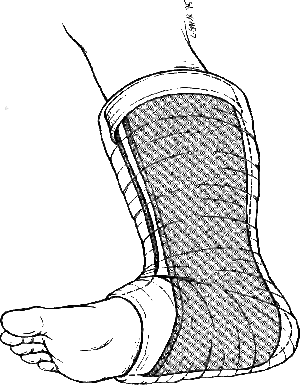Stirrup splint
Background
- Less inversion/eversion and less plantar flexion compared to posterior splint.
Indications
- Similiar to Posterior ankle splint
- Great for ankle sprains
Procedure

- Assess distal pulse, motor, and sensation
- Apply padding and splint material (e.g. Ortho-glass) as shown
- Ankle should be in neutral position at 90 degrees
- Splint should end mid calf [1]
- Maintain position until splint material hardens and secure to leg (e.g. ace wraps)
- Reassess distal pulse, motor, and sensation
See Also
References
- Splints and Casts: Indications and Methods http://www.aafp.org/afp/2009/0901/p491.html Accessed April 5, 2017
This article is issued from Wikem. The text is licensed under Creative Commons - Attribution - Sharealike. Additional terms may apply for the media files.